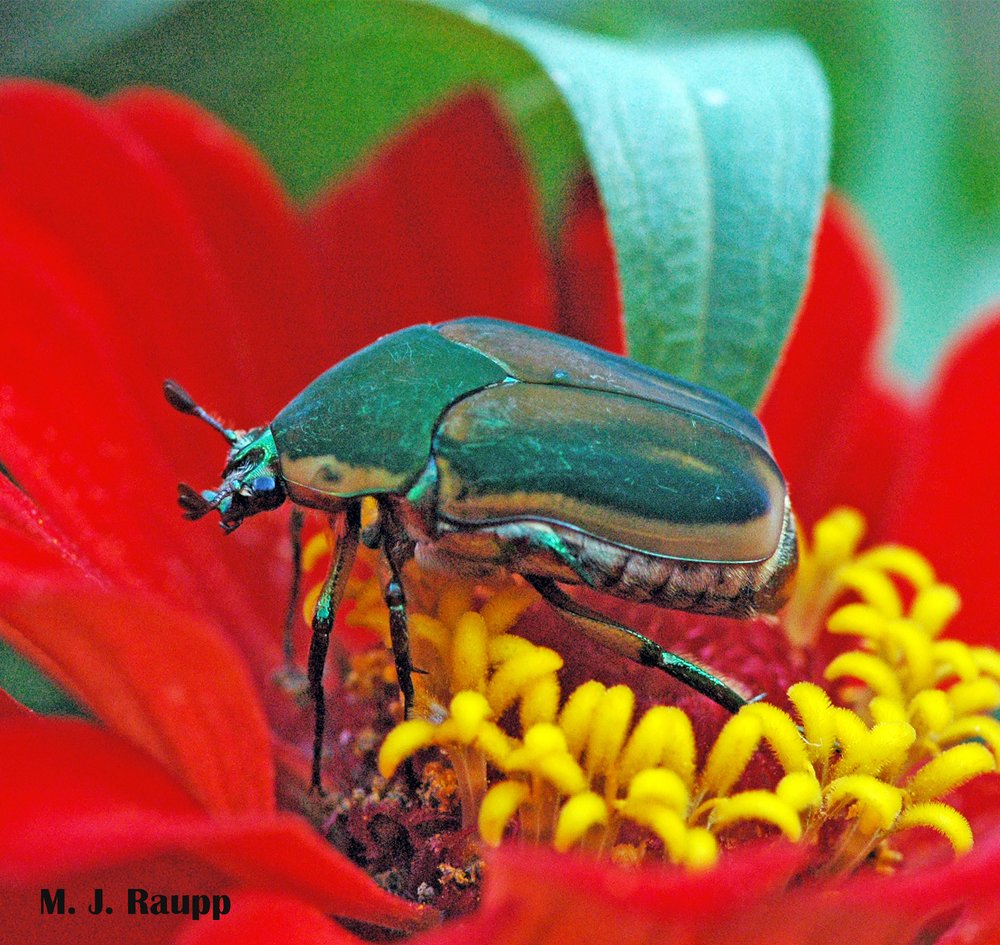
Caught by the lens of a cell phone as it rested on some bare soil, this image reveals a Green June Beetle that was buzzing above the lawn. Credit: Chris Millward
This week we leave the world of worms and return to the realm of six-legged creatures. Back in mid-July, an inquisitive mathematics teacher shared an image of a striking large green scarab beetle groveling in a bare patch of soil. On recon to the property, I was amazed to see scores of large bumble bee–like fliers zooming just above the surface of the turf. Occasionally one of the fliers would dive-bomb into the grass. After examining one such crash site, I realized these were not demented bumble bees, rather they were very large scarab beetles known as Green June Beetles. The flight patterns and buzzing sounds of Green June Beetle adults are strongly reminiscent of large bumble bees. Perhaps, these behaviors are a clever way to ward off would-be predators that learned not to mess with large buzzing, stinging insects.
At first glance, this backyard appears perilously infested with large swarming insects that just might sting. On closer inspection, these aerial acrobats turned out to be harmless Green June Beetles. They love to eat fresh fruit. This one took a break from its antics to enjoy a sweet cherry I placed in the lawn.
While most beetles spread their hard outer wings to fly, Green June beetle and their kin simply lift their hardened outer wings, expand membranous hind wings, and take off. Male beetles zoom in the morning as they search for mates. Females also fly low as they search for suitable places to deposit eggs in the soil. Once the female locates a favorable spot, she burrows several inches into the earth, makes a large sticky ball of soil and proteinaceous goop (technical term), and deposits eggs in it. Eggs hatch in a few days into small C-shaped white grubs. During the day the white grubs rest in a burrow underground, but at night they move to the surface of the earth to eat decaying organic matter.
Watch as green June beetles take flight first at full speed and then slowed by 95%. See the unusual position of the wings where hard outer wings remain closed and membranous hind wings extend outward and are used for flight.
These unusually large grubs have an equally unusual mode of getting from place to place. Although Green June Beetle grubs have well developed legs on their thorax, legs are not the primary mode of locomotion when they rise from the earth. These wiggly critters have a series of stout hairs on the upper surface of their back. To move above ground, the grub rolls on its back and with peristaltic motions it wriggles across the surface of the ground. The stout dorsal hairs contact the substrate and provide ample traction for surprisingly rapid movement.
Using a backstroke even Michael Phelps would admire, a Green June Beetle larva races across my patio.

Doesn’t this Green June Beetle look lovely posed on a flowerhead?
Soils with organic mulches and farm fields that receive applications of manure are highly attractive to the egg-laying females and may be loaded with grubs. The lawn which inspired this episode receives liberal nutrient subsidies from the household pooch and trespassing deer. Unlike their more destructive relatives, Japanese beetles, Asiatic Garden Beetles, and Oriental Beetles, Green June Beetles are not serious pests of roses, lindens, or other plants. The burrowing activity of grubs causes problems on highly managed turf in golf courses. Their primary foods are thin-skinned fruits such as berries and grapes. I have also observed several adults congregating on a wounded tree to slurp fermenting exudates. Fresh fruit and fermenting beverages sound just fine on a hot summer’s day. These Green June Beetles just may be a bit smarter than we think.
Acknowledgements
We thank Chris Millward for sharing the image of the Green June Beetle that inspired this episode. Information for this Bug of the Week came from Daniel Potter’s excellent reference book “Destructive Turfgrass Pests”, and the interesting article “Mimicry of Hymenoptera by Beetles with Unconventional Flight” by R.E. Silberglied and T. Eisner.
No comments:
Post a Comment